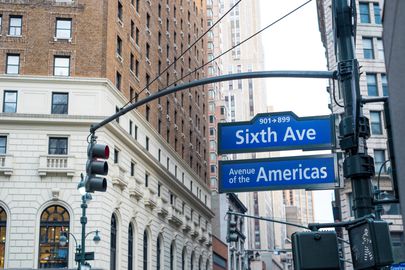

Sixth Avenue, with its northbound traffic, is one of the most diverse thoroughfares in Manhattan. Starting at Franklin Street below Canal Street and ending at Central Park South, that is, 59th Street, the avenue runs through some of the city's most important districts: TriBeCa, SoHo, Greenwich Village, Chelsea, the Garment District and the easternmost border of the Theater District. Initially, Sixth Avenue even continued north after Central Part, but that stretch was renamed Lenox Ave at the end of the 19th century, and at the end of the 20th - Malcolm X Boulevard.
From 1878 to about 1940 Sixth Avenue was the main track for the IRT elevated railway line, commonly known as the El. During World War II, after the demolition of the railway, there were rumors that the scrap metal was being sold to Japan through an export business in America's west coast. Several years after the war, however, the matter was cleared up and it was proven that none of the railway metal had ever come into Japanese possession.
In 1945 Sixth Avenue's name was officially changed to the Avenue of the America's by New York Mayor Fiorello La Guardia in order to honor "Pan-American ideals and principles," according to the bill. The mayor hoped that the new name would give the unattractive avenue a cosmopolitan appeal, inspiring international trade. His intuition was correct. Starting in the 1960s new, glass-slab skyscrapers began rising on what is called "the corporate stretch," from 42nd to 59th Streets. These skyscrapers are used today as headquarters for some of the most prestigious multinational enterprises. Among them are: the Bank of New York Tower between 42nd and 43rd, the News Corp. Building between 47th and 48th, the Exxon Building between 49th and 50th, and the Time Life Building between 50th and 51st.
Below 42nd Street, all the way down in Greenwich Village, stands one of the city's three or four neo-gothic structures: the Jefferson Market Branch Public Library. Built in 1877 and formerly a courthouse, it has a clock tower, gables, pinnacles, Byzantine embellishments and stained-glass windows. If you are ever in the village, do not forget to stop by and check out a book.